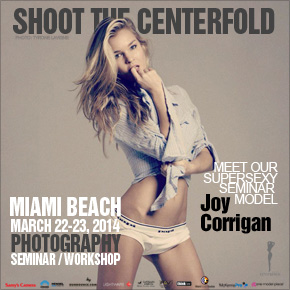Submission Advice for Photographers
Here’s a question we get a lot and I am going to explain how model submissions works so there is no confusion when submitting images to a publication or editors. (Each publication has their own regulations and policies – the information here is based on my own experience).
The myth amongst many photographers is that the hotter the model, the better your chances are of getting her published. This is absolutely correct, but with a caveat, because while you may raise an editor’s eyebrows, the truth is that editors at top publications get hot girly images all day long from hundreds of photographers looking for their big break and think their stuff is going to be the next big thing.
As this is a step in the right direction, it’s also, frankly, quite boring for the editors to see the same thing every day. Conceptual beautiful pictorials and well concieved stories get an editor’s attention way faster than a few sexy images of a beautiful girl. Just imagine how boring it would be if you had to eat the same chicken noodle soup every day, day in and day out… you get the picture.
I remember, while working at Playboy Studios during my shoots in Chicago and Los Angeles, seeing boxes on top of boxes filled with submission envelopes literally falling all over the place and getting piled up of the side just as if they were junk mail waiting to be heaped into the trash can, which isn’t too far from the truth.
You do NOT want to fall into that pile, and if you do, you at least want to be at the top of the pile to be considered for the publishing. You want to stand out! You want to get the call back immediately after the editor sees your submission! You need to think very clearly before you send your submission. Here are a few important points to consider:
 1. Is your model suitable for the publication to which you are making a pictorial submission?
1. Is your model suitable for the publication to which you are making a pictorial submission?
2. Are you submitting a model to be considered for future pictorials, or submitting images in an attempt to get your own pictures/pictorial published? (Make sure to clarify!)
3. Does your photo submission offer enough variety and especially a concept for a possible pictorial?
4. Based on the consistency of your shooting/pictorial submission, does it tell a tale for an experienced editor’s eye and make you stand out as far professionalism goes? An experienced eye can tell a lot from an image(s), like if the production, your lighting skills, consistency of posing, framing, and if you see beauty that measures against some of the better photographers’ works that editors deal with on a daily basis.
I remember sitting in the Playboy’s photo director’s office a watching some of the new pictorials been edited. The director told me that there was nothing more pleasing for him than doing an edit for a pictorial from well-produced images where everything just worked! This includes lighting, wardrobe, concept, poses, story, hair and makeup, and most importantly, that the model looks great and that you captured a variety of images that gives the editor a few choices to work with for the pictorial.
There was also plenty of times where I heard and saw editors not so happy with the results and performance of a photographer. This can occur for several reasons, pretty much the opposite of the techniques mentioned above. And you might even get a call or a nasty email from the editor who will be questioning your capabilities and wishing you a better performance in the future. (And how do I know this? Take a wild guess!)
5. No so long ago, I saw a post on social media where this photographer was questioning his readiness as a photographer and if he should take the leap and give it a shot to see if he has what it takes. I have been following this gentlemen’s work for a quite some time and I know better. He is more than ready, as far as his ambition, lighting and visualizing goes. But where he falls short is in his mental readiness! Are you ready, visually and mentally, to swim with sharks? You’d better be, if you hope to be successful.
6. Have you come to realize that editors are not then getting back to you? Where is the problem? You decide that it would be better to straighten things out by calling the editor , getting to the root of the problem, and see what’s the holdup!
As your submission images and model may be wonderful, you should also consider that wonderful is a very broad term. Your images are just as good, no better or worse than the other submissions, but they seem to get more attention than others. Whattha heck? Then you even decide to argue with the editor and try to convince him to like your images, which make you very unpopular and reduced your chances of being published to non-existent!
If your images are popping and what I call publishable, trust me! You will get a prompt reply, either via email or by phone. Editors recognize good work and good photography!
Standard advice for preparing digital camera files for submission:
- Use a pro-level camera with a “true” (non-interpolated) resolution of at least 6 megapixels. This will give an uncompressed file size of at least 17MB at 8 bit.
- Carefully consider your choice of lens. Lens quality is just as important today as it ever was.
- The choice between shooting in RAW, Tiff or JPEG is a matter for your own or publication workflow. Shoot in RAW for maximum control in post-processing. (Most high-end publications except only non-edited RAW images.) If shooting in JPEG, always use the “Fine” (least compressed) setting. Modern professional DSLRs produce excellent jpegs, which are visually indistinguishable from RAW or Tiff. With lesser cameras it may be necessary to shoot in RAW to achieve acceptable image quality.
- Capture images at as low an ISO setting as practicable. (ISO 50, and 100 is standard in Playboy and most high-end fashion magazines.)
- Turn off all in-camera sharpening.
- Before working on fine JPEG’s, they should first be re-saved as tiffs or another non-lossy format, e.g. psd. Never re-save JPEG’s in JPEG format – this will result in permanent loss of data and degraded image quality.
- RAW files should be checked for correct exposure, color cast, etc, and any adjustments should be made at this stage. When converting from RAW, ensure all sharpening is turned off – it’s applied by default in Photoshop.
- If necessary, rotate the image so that it’s “the right way up”.
- Do not crop your images excessively – after cropping, your file should still have an uncompressed file size at least 17MB at 8 bit. (Most editors want the images as shot in camera.)
- Open your images to 100%, and check for dust contamination on the sensor. This shows up as dark, circular marks – particularly noticeable in the sky and similar areas. Thoroughly check the upsized image at 100% and make any necessary corrections using the Clone Tool, Healing Tool or the History Brush technique as appropriate.
Rejected images and possible causes:
Camera shake
The image is blurred or soft because the camera moved when the picture was taken. Blurred and soft images are rejected if editors feel it was not artistically intended or it is unsaleable. Try using a faster shutter speed, steady hand, or a tripod.
Chromatic aberration
 Chromatic aberration or ‘coloured fringing’ is shown as magenta/green or red/cyan fringing in areas of an image that have greater contrast. Poor quality optics and extreme wide-angle lenses tend to show Chromatic Aberration especially towards the edge of the frame. Purple fringing’ is a similar phenomenon, found in some digital cameras. It is caused by the optical characteristics of the camera sensor, and can extend right across the frame.
Chromatic aberration or ‘coloured fringing’ is shown as magenta/green or red/cyan fringing in areas of an image that have greater contrast. Poor quality optics and extreme wide-angle lenses tend to show Chromatic Aberration especially towards the edge of the frame. Purple fringing’ is a similar phenomenon, found in some digital cameras. It is caused by the optical characteristics of the camera sensor, and can extend right across the frame.
Color cast
The image is tinted with an unwanted color caused by incorrect white balance on your camera or scanner. Calibrating your monitor regularly can also help prevent color casts. Although some color choices can be seen as artistic, these choices are left to the editor and rejected if its color cast makes it unsaleable.
Compression artifacts
The image has a blocky or patchy appearance caused by excessive compression. It is particularly noticeable in areas of flat colour such as skies and can appear as Jpeg “bubbles” around the edges of the image. To minimise these artifacts work on your images in RAW or TIFF format and save as a Jpeg once only.
Data loss or corruption
The image shows areas of subtle pixilation or zero data. To reduce the risk of this problem burn your CD or DVD at the slowest speed possible and make sure it is verified. Also check the first and the last few images on the disc for problems, as this is where most occur.
Excessive sharpening
The image appears “edgy” or unsightly artifacts are visible. Sharpening should be applied only once and this is best done at the repro stage.
Excessive similars
A series of similar images which have almost identical compositions or only slightly different exposures. Choose images with different angles, framing or model’s expressions etc. However, you must tightly edit your images otherwise they will appear further down search results. Editors do not want to spend time editing through your work unless separately requested. (Time is money.)
High contrast
The image highlights are blown out and shadow detail is crushed.
Interpolation artifacts
The image exhibits rather intrusive artifacts and degradation of detail resulting in an overall soft look, a “mottled” texture or “jaggies” on edges. These symptoms occur when you interpolate an image beyond the capabilities of the camera from which it came.
Noise
 Chroma noise gives a mottled, distorted effect that usually contains green and pink/purple colours. It can particularly cause problems on skin tones, skies and shadow areas. Electronic chroma noise is the appearance of distortion within a digital image usually caused by using high ISO levels when shooting. Different cameras are better at reducing the appearance of noise than others, but you should always try and shoot on as low an ISO level as possible.
Chroma noise gives a mottled, distorted effect that usually contains green and pink/purple colours. It can particularly cause problems on skin tones, skies and shadow areas. Electronic chroma noise is the appearance of distortion within a digital image usually caused by using high ISO levels when shooting. Different cameras are better at reducing the appearance of noise than others, but you should always try and shoot on as low an ISO level as possible.
Orientation
The image is not the right way up for viewing on a screen. It may be inverted, upside down or at an angle.
Out of focus
Editors will reject an image if it’s not artistically intended to be out of focus. Also, it must look out of focus at comp size so that it is obvious to the viewers.
Over manipulated
The image is clearly over manipulated. Examples are the excessive use of “levels” or “curves” which leave an image looking posterised, “blocky” or with distorted color.
Poor exposure
The image appears rather flat or washed out. Correct exposure ensures maximum tonal range in an image. You can check and adjust the exposure using the histogram in Photoshop (Under Image > Adjustments > Levels).
Soft due to size
This is caused by over-interpolating (upsizing) images beyond their capabilities.
Unsuitable material
Although the technical standard of your work maybe be fine, certain material is not suitable for our target market. This includes, but is not limited to improper or unusable style and images which infringe the rights of any third party. If you shoot this type of content you may have more sales success from an alternative outlet. This failure reason also applies to watermarked images.
For more details and and how get your images in front of top editors, join Shoot The Centerfold’s March 22-23 seminar / workshop in Miami. I hope this have been helpful information and never give up on your goals and dreams!
Jarmo Pohjaniemi

© 2014 Copyright ShootTheCenterfold.com. All rights reserved.




















Many detailed and valuable points here explain precisely the truth, there are RULES to the game as any of them are played. The idea and mantra I hear to the contrary ( There are no rules ) are for the artist not the craftsmen.
Solid advice and great information. It’s good to have all the information laid out in an easily digestible format. For many photographers, it seems like a closely guarded secret how you go about getting your work published. This article should be of use for many.